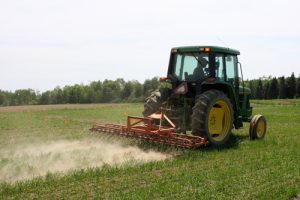Bulletin #1027, Growing Organic Barley in Maine
By Ellen Mallory, Extension Specialist and Assistant Professor, University of Maine and
Rick Kersbergen, Extension Professor, University of Maine
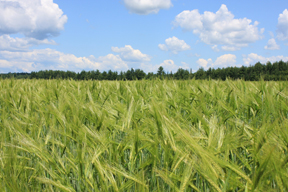
For information about UMaine Extension programs and resources, visit extension.umaine.edu.
Find more of our publications and books at extension.umaine.edu/publications/.
- Know Your Market
- Field Selection
- Field Preparation
- Crop Rotation
- Seed Sourcing and Variety Selection
- Soil Fertility
- Planting
- Underseeding
- Weed Management
- Disease Management
- Harvest, Drying, and Storage
Barley is grown in Maine for livestock feed and, to a lesser extent, for malt production. Maine’s cool climate and generally uniform rainfall favor spring barley production. Winter barley varieties are available, but they do not have good winter survival in northern New England. Spring barley requires a moderately deep, well-drained soil to allow early planting and good growth. Proper crop rotations, soil pH, and timing of several management practices are also critical to obtaining optimum yield and quality for organic barley.
This fact sheet discusses organic barley production from field selection to harvest and storage. The Preparing for a Spring Seeding section at the end of the fact sheet outlines key steps for preparing a new field for growing organic barley.
Know Your Market
The very first step in producing organic barley is to decide where you plan to sell it, so that you can determine which varieties to plant and what quality standards will need to be met. Barley sold for malt must meet much higher quality standards than barley sold for feed. Purchasers of malting barley will often specify which varieties to grow and generally expect a minimum of 95% germination, a Falling Number1 above 250 seconds, grain protein levels between 10.5 and 13 percent, high test weights, and acceptable levels of the mycotoxin deoxynivalenol, or DON1 (generally <1ppm). For feed barley, high test weight and protein levels are desirable characteristics, and DON levels also must be below certain levels depending on the livestock to which barley is fed. Finally, for both markets, be clear about the drying and cleaning expectations and who assumes the cost for crop shrinkage.
1For more information about the Falling Number and DON, see the University of Maine Cooperative Extension Fact Sheet #1019, “Understanding Wheat Quality: What Bakers and Millers Need and What Farmers Can Do.”
Field Selection
Barley grows best on a moderate to well-drained soil. It is more sensitive than oats or rye to “wet feet” and will be stunted by excessive soil moisture, especially if it occurs early in the season. For this reason, it also is important to avoid or correct compacted areas that would tend to be easily saturated and limit root growth.
Selecting well-drained fields also facilitates the timely establishment of the crop. Barley should be planted as early as possible in the spring to encourage maximum tillering, good pollination during cooler temperatures, and good grain fill and dry down. Early planting also gives barley a competitive advantage over summer annual weeds that germinate in warmer weather and can help prevent the development of virus diseases that can stunt plants and reduce yields.
Field Preparation
Soil Testing and Soil pH
Barley is sensitive to low soil pH. A soil pH of 6.0 to 6.5 is necessary for optimum yields, and a soil pH of 5.5 or below will severely reduce yields. Oats are more tolerant of low pH levels and therefore are a better choice for fields where a low soil pH is maintained for a rotation crop such as potatoes, or where liming has not yet achieved optimal pH levels.
Take a standard soil test to determine your soil’s pH. Soil testing also provides important information on the status of the nutrients needed for successful barley growth, such as phosphorus and potassium. Soil testing should be repeated every year, initially, and then every few years to successfully manage soil pH and fertility. A standard soil test at the University of Maine Soil Testing Service is an important $15 investment! An additional soil quality test is also now available. For more information on testing your soil please refer to UMaine Extension’s Fact Sheet Bulletin #2286, Testing Your Soil or visit the Analytical Lab and Maine Soil Testing Service website.
Fall Preparation
Raising soil pH takes time, so it is critical to test your soil and, if needed, apply the recommended amount of liming agent the year before you plant barley. Lime should be applied to reach a minimum pH of 5.8, with a target of 6.0 to 6.5 for optimal growth. Most agricultural lime is from naturally occurring limestone and is allowed under organic certification. Liming materials that are not allowed include hydrated limes, burnt limes, and some pelletized materials depending on their composition. Wood ash also can be used as a liming agent because of its high calcium content but must be produced exclusively from untreated and unpainted wood and not contain any prohibited materials for use under organic certification. Growers should check with their certification agency to make sure that the mill that is producing the ash is on the list of “acceptable” sites. Wood ash also supplies phosphorus, potassium, and other nutrients. The liming ability of different types of wood ash varies so it is important to get material test results from the supplier that provides the liming equivalent of the wood ash, as well as its nutrient content. For more information on using wood ash, see the University of Maine Cooperative Extension Fact Sheet “Bulletin #2279, Using Wood Ash on Your Farm.”
If barley is to follow a perennial sod crop, the field should be prepared the prior summer or fall. Waiting to kill a sod until the spring can lead to inadequate weed control, poor barley stands, and low yields. Perennial weeds, in particular, are extremely difficult to control in the crop using organic methods. For this reason, we recommend that producers kill perennial sods the season before planting barley. Deep tillage and or moldboard plowing can reduce the annual weed seed bank and potentially kill perennial grasses such as quackgrass. If perennial weed regrowth is a concern, repeated shallow tillage at approximately three-week intervals (“tilled fallow”) can be used to exhaust the weeds’ energy reserves. Tilled fallow may also reduce the annual weed seed bank. To allow time for effective use of tilled fallow, the first tillage event should occur in early August. Lime and soil amendments, such as compost, can be added at this time as well.
One issue with conducting tillage in late summer and fall is that leaving soil bare during the winter can lead to erosion and nutrient loss. We recommend that growers leave time to plant a cover crop to protect the soil and take up nutrients released from the previous crop or plowed-in sod. Using annuals that winter kill will facilitate early planting the following spring. These include oats, “tillage radish,” annual ryegrass, annual clovers (such as crimson clover), or mixes of these crops.
Crop Rotation
Crop rotation is the foundation of successful organic crop production. Proper rotations, combined with proper crop management, are a key to managing weeds, insects, diseases, and fertility. Whenever possible, growers should disrupt pest cycles by rotating crops with different life cycles (annuals versus perennials), planting dates (fall, early spring, summer), row spacing (solid seeded versus wide rows that allow cultivation), and crop families (grasses versus broadleaves). Avoid planting barley after other small grains like oats and wheat. Help meet crop fertility needs by rotating crops with different nutrient demands, nitrogen-fixing ability, and rooting depths.
Seed Sourcing and Variety Selection
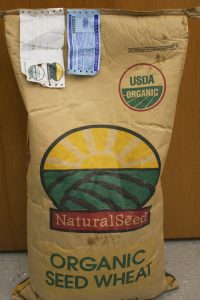
One of the challenges of growing organic grains is finding an organic seed. The National Organic Program (NOP) requires that growers search for organic seed sources and use them when available. If the organic seed cannot be sourced, organic producers are allowed to use the untreated conventional seed as an alternative but must document the failed search for organic seed in their organic certification records. To increase chances of finding organic seed, growers should try to locate their seed source in the fall.
Another challenge can be finding high-quality seed. High-quality seed may cost more, but it can easily pay for itself in terms of increased crop vigor and yield. Seed certification programs exist in most states and Canada. These programs use field inspections and seed quality testing to assure that seed that carries the certified designation, as indicated by a blue bag tag, has high varietal purity, high germination rates, minimal weed or other crop seed content, no noxious weeds, and minimal seed-borne diseases. Seed certification is distinct from organic certification, which makes it possible to have certified organic, certified seed, or “double certified” seed.
Selecting appropriate varieties is critical for yield, disease tolerance, straw strength, test weight, and other traits. Barley varieties are either six-row or two-row types. This refers to the number of rows of developed kernels on a mature seed head. Two-row types develop more seed heads per acre and have consistently larger kernels, while six-row types develop more kernels per head. Barley yields are typically higher for six-row types, but two-row types consistently produce higher test weights. Test weight (48 pounds per bushel is the standard) is important to market value because it is highly correlated with the available energy content for livestock feed and malting.
Organic producers should pay attention to traits such as early-season vigor and taller varieties that might provide increased weed competition. To help select varieties that perform well in our region, consult the barley varietal information published by the Crop Improvement Associations of other northern US states, like Minnesota and North Dakota, and the Ontario Cereal Crop Committee.
Soil Fertility
Barley is a moderate nitrogen feeder, with typical recommendations ranging from 60 to 80 pounds per acre of available nitrogen. Insufficient nitrogen will limit yields and too much can result in lodging, weed growth, and in the case of malt barley, excessively high grain protein levels. Nitrogen source options include plowed-in legumes (ex. red clover, alfalfa, or crimson clover), manures, compost, poultry litter, and seed meals. These sources have varying amounts of available nitrogen so growers should have these amendments tested to evaluate how much nitrogen will be available to the barley crop and adjust application rates accordingly. Materials with high levels of readily available nitrogen should be applied in the spring to avoid overwintering losses.
The need for phosphorus, potassium, and other nutrients is best determined with a soil test. Many nitrogen sources, like manure, also provide substantial amounts of these nutrients. Rock phosphate and bone meal can serve as supplemental sources of phosphorus, but these types of amendments vary in terms of how readily available the phosphorus is for plant uptake. For supplemental potassium and other nutrients, consider sul-po-mag, untreated potassium sulfate, or granite dust. Always check with your certifier about the status of a particular material before applying it to your land.
Planting
Seed Bed Preparation
Spring disking and light harrowing is often sufficient for tillage on soils that have previously been in crop production or were prepared during the previous season. The seedbed should be fine, firm, and smooth. If the soil is too loose, seeds may be planted too deeply and germination may be reduced or delayed. Poor stands, lower yields, and increased weed competition will result. Pre-plant firming of the seed bed with a land roller will help firm the soil and improve the seed bed.
Date
Planting date and planting depth are critical for barley, as they are for all spring cereal crops. Barley must be planted early and emerge quickly to take advantage of longer daylight hours (photoperiod) and cooler temperatures, which help provide shorter, stronger straw, good pollination, and head development, and higher grain yield. Early planting also leads to earlier grain ripening, which reduces the risk of late-season disease development and allows lower grain moisture levels at harvest. For northern Maine, the general rule of thumb is to plant before May 8th for optimal growth and to increase the seeding rate by 1% for every day after that date to compensate for reduced tillering. Barley planted after June 1 is unlikely to produce a high quality and productive crop.
Seeding Rates
Optimal plant populations are critical for weed control and high barley yields. To effectively suppress weeds, organic producers generally seed at rates that are 25-50% higher than those used for conventional production. This translates to a seeding rate of roughly 2.5 to 3 bushels per acre (120 to 144 pounds per acre). Under ideal conditions, the resulting plant population would be roughly 1,250,000 to 1,500,000 plants per acre assuming good quality, plump seeds (12,500 seeds per pound), 95% seed germination, and 12% emergence loss. Growers should increase seeding rates to compensate for lower germination rates and higher emergence losses, but be aware that seed costs can comprise a significant portion of production expenses.
Growers planning to purchase new planting equipment should consider precision seeding (as achieved with an air-seeder) and narrow row spacing (4 to 5 inches) as they can aid in establishing a more uniform, dense crop that will provide better weed control. Additionally, other techniques such as broadcasting a portion of seed before the drill or planting twice at a roughly 45-degree angle have been used to increase plant density and uniformity of spacing.
Planting Methods
Seeding barley with a grain drill followed by a roller or culti-packer is the preferred planting practice. Seeding depth should be 1 inch under most conditions (1½ inches in dry soil); seedling vigor is greatly reduced if seeds are planted too deeply. Unfortunately, placement with conventional grain drills can vary from 1 to 4 inches if the seedbed is uneven or the soil conditions are too soft. Firm, level seedbeds avoid this problem. If your plants emerge unevenly, uneven planting depth is usually the culprit.
Barley also may be broadcast seeded, but extreme care should be taken to avoid covering the seed too deeply when working it into the soil. A lightweight harrow or a disk, set shallow, may be used to incorporate broadcast barley seed, followed by a land roller or culti-packer to firm the seedbed. Also, care must be taken to broadcast the seed as uniformly as possible. Due to variation in spreading uniformity and depth of incorporation, it is difficult to achieve uniform germination with broadcast seeding.
Underseeding
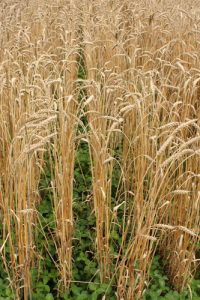
Barley and other small grains are ideal crops for underseeding with a legume or grass-legume mix. Underseeding is an excellent, low-risk way to establish an annual green manure crop for nitrogen production or to establish a new, perennial forage stand. The undersown crop also will help suppress weeds. Red clover and low-growing white clover varieties are preferred crops for underseeding because they tolerate the low light intensity under a small grain canopy and tend to grow outward to capture more light rather than growing upward. Inoculate legume seed with the appropriate Rhizobium strain to assure nitrogen fixation.
Underseeding generally does not reduce yields, but it may make straw and or grain harvest more difficult. If the barley variety is short or if the harvest is delayed, red clover may grow too tall and interfere with combining. This problem can be reduced by delaying underseeding until the last tine weeding, prompt harvesting of the barley, or by using shorter varieties or types of clover.
Weed Management
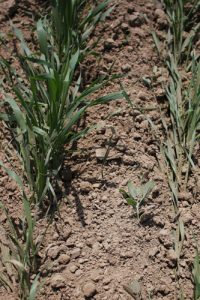
Managing weeds effectively in organic small grain production requires the use of multiple strategies: avoiding sites with high weed pressure; designing diverse rotations that vary the timing of seeding and cultivation events and that provide opportunities for tilled fallow; underseeding; and growing a vigorous crop to suppress weeds. The barley crop itself can provide much of the weed control through competition if it is seeded early enough and at the proper rate and seeding depth. Soil conditions that favor the barley crop’s growth, such as optimum soil pH, also help the crop out-compete weeds.
Once the crop is established, the primary weed management tool available to organic growers is tine weeding (also called “blind cultivation”). Flexible tine weeders or harrows (ex. Lely or Kovar) work by dislodging or burying small weeds. To avoid crop damage, they should be used before the crop emerges or after the crop has developed 3-4 leaves. Tine weeding is effective if soil conditions are dry and friable, and the weeds are just emerging (in the “white thread” stage). Tine weeding is less effective once the weeds start to root in the soil or if the soil is cloddy or wet. Larger-seeded weeds, like hemp nettle and mustards, are more difficult to control with tine-weeding than small-seeded weeds, like pigweed and lambsquarters. This is because they can germinate from lower depths and develop firmly established root systems more quickly. As well, grass weeds, both annual and perennial, are less susceptible to tine weeding than broadleaves. Grass weeds need to be controlled the season before planting or avoided through site selection.
Disease Management
While there are a few pesticides approved for use in certified organic production, their cost and effectiveness make them less useful for field crop production. Generally, organic small grain producers rely on cultural controls to manage the disease. These include using diverse crop rotations, selecting resistant varieties, planting early, growing vigorous crops, and burying any disease-carrying crop residues.
Fusarium head blight is a particularly serious disease for barley in our region because it thrives in humid climates and produces a mycotoxin, deoxynivalenol (DON), that can be harmful to humans and animals. The United States Food and Drug Administration (FDA) has established a maximum DON guideline of 1 ppm for finished human products. The recommended threshold for DON for animal feed is less than 10 ppm with the actual amount dependent on the species of animal that will be fed and the portion of the diet that is comprised by the grain crop in question2. In areas where Fusarium is prevalent, barley should not follow other small grains or corn. Fusarium spores overwintering on the residues of grass crops and weeds can infect a subsequent crop if cool, humid weather that favors disease development occurs just before and during flowering. This is when the crop is most susceptible to infection.
2For more information, see the FDA guidance document on advisory levels for DON in grain that is listed in the references below.
Harvest, Drying and Storage
Barley ripens earlier than most oat and wheat varieties grown in Maine. Over-ripe barley may shatter during harvest and this lost grain can significantly impact profitability. Barley dries easily, so harvesting earlier at 16% moisture to avoid shatter losses often returns enough extra yield to exceed the drying cost required to reduce the moisture to 12-13% for storage. Growers can reduce drying time and protect crop quality by cleaning barley grain immediately after harvest to remove weed material. Clean, dry barley that is free from awns and chaff, will maintain test weight and reduce costs associated with shrink.
References
Griffin, T. 2006. Bulletin #2279, Using Wood Ash on Your Farm. University of Maine Cooperative Extension, Orono, ME. Available online https://extension.umaine.edu/publications/2279e/
Mallory, E., T. Bramble, M. Williams and J. Amaral. 2012. Bulletin #1019, Understanding Wheat Quality — What Bakers and Millers Need, and What Farmers Can Do. University of Maine Cooperative Extension, Orono, ME. Available online https://extension.umaine.edu/publications/1019e/
U.S. Food and Drug Administration. 2010. Guidance for Industry and FDA: Advisory Levels for Deoxynivalenol (DON) in Finished Wheat Products for Human Consumption and Grains and Grain By-Products used for Animal Feed. Division of Plant and Dairy Food Safety, Center for Food Safety and Applied Nutrition, U.S. Food and Drug Administration. 4 pp. College Park, Maryland. Available online at https://www.fda.gov/regulatory-information/search-fda-guidance-documents/guidance-industry-and-fda-advisory-levels-deoxynivalenol-don-finished-wheat-products-human
Reviewed by Dr. Gregory Porter, Professor of Agronomy, University of Maine and Andrew Plant, Assistant Extension Professor, University of Maine.
Photos by Ellen Mallory.
Information in this publication is provided purely for educational purposes. No responsibility is assumed for any problems associated with the use of products or services mentioned. No endorsement of products or companies is intended, nor is criticism of unnamed products or companies implied.
© 2013
Call 800.287.0274 (in Maine), or 207.581.3188, for information on publications and program offerings from University of Maine Cooperative Extension, or visit extension.umaine.edu.
In complying with the letter and spirit of applicable laws and pursuing its own goals of diversity, the University of Maine System does not discriminate on the grounds of race, color, religion, sex, sexual orientation, transgender status, gender, gender identity or expression, ethnicity, national origin, citizenship status, familial status, ancestry, age, disability physical or mental, genetic information, or veterans or military status in employment, education, and all other programs and activities. The University provides reasonable accommodations to qualified individuals with disabilities upon request. The following person has been designated to handle inquiries regarding non-discrimination policies: Director of Institutional Equity and Title IX Services, 5713 Chadbourne Hall, Room 412, University of Maine, Orono, ME 04469-5713, 207.581.1226, TTY 711 (Maine Relay System).


